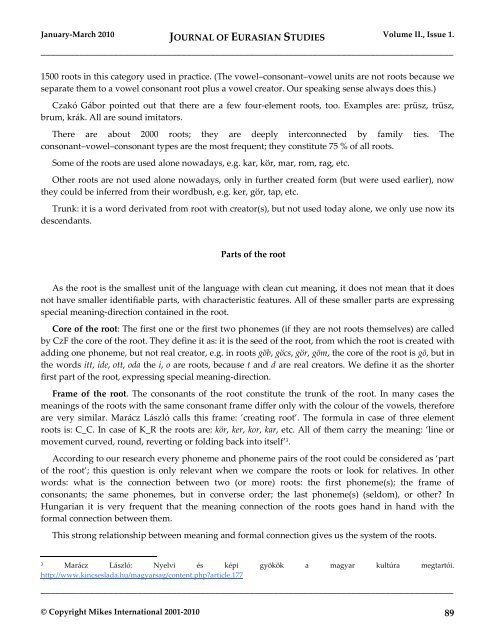EurasianStudies_0110..
EurasianStudies_0110..
EurasianStudies_0110..
Create successful ePaper yourself
Turn your PDF publications into a flip-book with our unique Google optimized e-Paper software.
January-March 2010 JOURNAL OF EURASIAN STUDIES Volume II., Issue 1.<br />
_____________________________________________________________________________________<br />
1500 roots in this category used in practice. (The vowel–consonant–vowel units are not roots because we<br />
separate them to a vowel consonant root plus a vowel creator. Our speaking sense always does this.)<br />
Czakó Gábor pointed out that there are a few four-element roots, too. Examples are: prüsz, trüsz,<br />
brum, krák. All are sound imitators.<br />
There are about 2000 roots; they are deeply interconnected by family ties. The<br />
consonant–vowel–consonant types are the most frequent; they constitute 75 % of all roots.<br />
Some of the roots are used alone nowadays, e.g. kar, kör, mar, rom, rag, etc.<br />
Other roots are not used alone nowadays, only in further created form (but were used earlier), now<br />
they could be inferred from their wordbush, e.g. ker, gör, tap, etc.<br />
Trunk: it is a word derivated from root with creator(s), but not used today alone, we only use now its<br />
descendants.<br />
Parts of the root<br />
As the root is the smallest unit of the language with clean cut meaning, it does not mean that it does<br />
not have smaller identifiable parts, with characteristic features. All of these smaller parts are expressing<br />
special meaning-direction contained in the root.<br />
Core of the root: The first one or the first two phonemes (if they are not roots themselves) are called<br />
by CzF the core of the root. They define it as: it is the seed of the root, from which the root is created with<br />
adding one phoneme, but not real creator, e.g. in roots göb, göcs, gör, göm, the core of the root is gö, but in<br />
the words itt, ide, ott, oda the i, o are roots, because t and d are real creators. We define it as the shorter<br />
first part of the root, expressing special meaning-direction.<br />
Frame of the root. The consonants of the root constitute the trunk of the root. In many cases the<br />
meanings of the roots with the same consonant frame differ only with the colour of the vowels, therefore<br />
are very similar. Marácz László calls this frame: ’creating root’. The formula in case of three element<br />
roots is: C_C. In case of K_R the roots are: kör, ker, kor, kar, etc. All of them carry the meaning: ’line or<br />
movement curved, round, reverting or folding back into itself’ 3 .<br />
According to our research every phoneme and phoneme pairs of the root could be considered as ‘part<br />
of the root’; this question is only relevant when we compare the roots or look for relatives. In other<br />
words: what is the connection between two (or more) roots: the first phoneme(s); the frame of<br />
consonants; the same phonemes, but in converse order; the last phoneme(s) (seldom), or other? In<br />
Hungarian it is very frequent that the meaning connection of the roots goes hand in hand with the<br />
formal connection between them.<br />
This strong relationship between meaning and formal connection gives us the system of the roots.<br />
3 Marácz László: Nyelvi és képi gyökök a magyar kultúra megtartói.<br />
http://www.kincseslada.hu/magyarsag/content.php?article.177<br />
_____________________________________________________________________________________<br />
© Copyright Mikes International 2001-2010 89

















